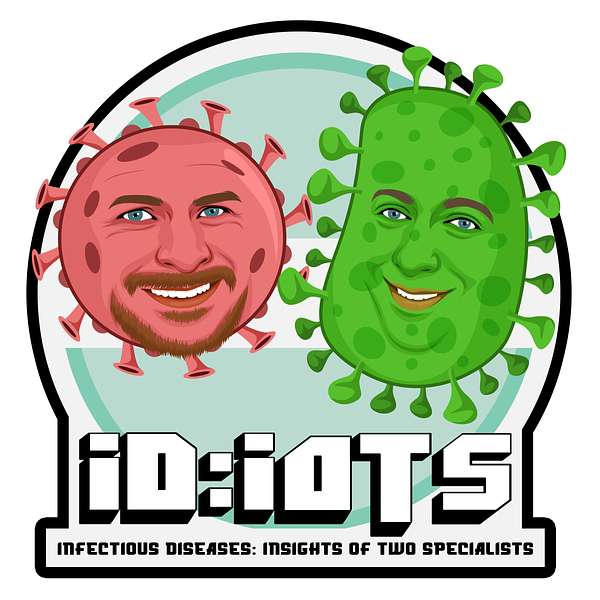
ID:IOTS - Infectious Disease Insight Of Two Specialists
Join Callum and Jame, two infectious diseases doctors, as they discuss everything you need to know to diagnose and treat infections. Aimed at doctors and clinical staff working in the UK.
Episode notes here: https://t.ly/8DyqW
Queries, comments, suggestions to idiotspodcasting@gmail.com
ID:IOTS - Infectious Disease Insight Of Two Specialists
69. Choosing an antimicrobial
How do you think about antibiotics?
This Christmas we give the best gift of all: no puns in an episode.
Join Jame and Callum as they talk about a method for thinking about and explaining antibiotics.
Here are the show notes for this episode: https://idiots.notion.site/69-Choosing-an-antimicrobial-4e7446a91ff6413aa14924a2ba905ffa
Questions, comments, suggestions to idiotspodcasting@gmail.com or on Bluesky @idiots-pod.bsky.social
Prep notes for completed episodes can be found here (Not all episodes have prep notes).
If you are enjoying the podcast please leave a review on your preferred podcast app!
Feel like giving back? Donations of caffeine gratefully received!
https://www.buymeacoffee.com/idiotspod
Was the night before Christmas. We were all having fun, but Callum and Jane couldn't think of a pun. So instead we decided though it filled us with woe to just jump straight in to this Christmas episode. Callum, how you doing?
Callum:I am good. I am in Christmas mode. Wear my Christmas jumper. I've got my Christmas glasses on. Wear my Christmas content lenses.
Jame:Oh my God, I'm having my Christmas whiskey.
Callum:Christmas hat, Christmas socks.
Jame:And rarely for an episode you've done the prep for this. So what are we talking about today,
Callum:I know what I'm talking about For once. Although actually it's just what's was in my head already.
Jame:BUt I think it's good to go through, actually. Yeah. Particularly for like our non, senior reg consultant audience members.
Callum:Actually, do you know the idea for this episode for me came from a colleague, and actually often this is where I get ideas for episodes for, was a colleague asked me the other day is they said, Callum, how do you think about antibiotics? And I was like, oh. And I hadn't really thought about it like. Like thinking about antibiotics, but when people, when I'm like on a ward round and I'm like teaching more junior members of the team and they ask me about antibiotics in a specific. Situation. What I often do, and this is I think this is quite often what I do on a sort of teaching ward anyway, is I get a scrap piece of paper and a pen and I just draw a diagram.'cause I always find that helps one for me to get that schema thoughts across like that, the way that I structure my thinking.'cause I think in a diagrammatic way often. sO it helps me explain it and it hopefully helps transmit that understanding to other people. And so I thought it might be useful. I'm just gonna explain how I think about antibiotics when I'm making a decision about which one to choose in a situation
Jame:Okay. And this is one to have a look at the prep notes for as well because Callum' done a sterling job going through all the individual bits.
Callum:It is color coordinated.
Jame:Ah. We will PA link to that, of course, in the show notes as we always do. But Kam, do you want to for the what an excellent thing to do in a podcast medium? Describe an image that you've created.
Callum:Yeah, just explained why the drawing was useful. This podcast that's, it's an immediate shot in the dark, isn't it? I'll try my best to paint you a picture. Was it? They say words, paint a thousand pictures.
Jame:Or Yeah, something like that. Yeah. So go. So go on. What are we doing here? What are we
Callum:Yeah. I'm gonna walk through it and if you want to open the prep notes, I know a lot of people were driving will listen to it, so don't do that. That would be bad. But when you stop driving, you could look at it then. So I guess. The way I think about when I'm choosing an antibiotic is I start with the bacteria and then work my way up the antibiotic and I start the basics and I'm gonna build up a patchy lasagna of the antibiotic selection here.
Jame:Oh, a very Christmasy
jame_1_12-20-2023_223610:anaerobeogy. Yes.
Callum:Oh yeah. Oh,
Jame:In Italy at
Callum:So I basically draw out a diagram and it's four squares, and in the top left corner is gram positive cocci. In the bottom right corner is Gram-negative. Bacilli, as are two main groups. And then in the top I've got Gram-positive bacilli. And the bottom left, I've got Gram negative Corki. So I've got my gram negatives at the bottom. Gram positives at the top, on the left, basi on the right, and there are four quadrants. And then I think okay, that's the four main ways I would categorize things. But don't forget ROEs and Ana robes or come on to talk about them later on. Essentially they cross all four quadrants. So I chuck a little square in the middle covering the intersection of those four squares to say Ana ropes. And I think that's a very basic starting point for to categorize
Bacteria.
Jame:yeah that's how I think of them as well. So yeah. anD then what's the next step?
Callum:And then I think a little bit more into, okay, what
Track 1:Gram-positive cocci are the most
Callum:important ones. So I'm gonna write down some genesis of an, of bacteria. Staphylococci streptococci enterococci in my Gram-negative. My gram-negative cauca. I'm thinking the Syria, so gonorrhea, meningitis, gram's de bcii, let's just say listeria, and then gram-negative. Ba cli, I've got intact. So this is just think a little bit about what organisms are we talking about in those groups, But this's worth thinking about some key organisms that we may or may not need to cover. And I add those in as a little box on their road and highlight them when I'm talking about this. And I say, okay, so in the grand
Track 1:positive cocci, we've got
Callum:the staff, we've got the strep, we've got the intra eye. On a very basic level, the other thing I'm always thinking about is MRSA. Now, luckily there isn't that much MRA where I practice, but it's always worth thinking, are the MRA positive before what's the prevalence of the traveled in centers where there's a lot of MRSA? This is probably more routine.
Jame:totally. Yeah. Yeah.
Callum:You could put in more complicated things like vancomycin resistant intra, but we're gonna keep it really simple. I'm not talking about that now.
Jame:Yeah. So this is Set at the sort of early years trainees In infection,
Callum:I'm trying to keep this real simple.'cause this is most of the time on ward drums. I'm teaching this to two years post-graduates or medical students.
Jame:Totally. Yeah. What about on the Gram-negative bacilli section?
Callum:So the on the gram negative Bais section, the other key thing I think about is whether I have to cover this or not is pseudomonas aosa,
Jame:So I suppose those two are the sort of big, difficult to treat or relatively difficult to treat and relatively common examples of their class,
Callum:yeah, and so that's where I get to with that categorization. Now I'm gonna add in two more complications. So the first one is that not all organisms will stain with your gram stain. So some just lack of cell wall or, the stain doesn't get in. One way of talking about those is saying atypical organisms and how you define that changes, and it's a quite vague class, but to keep things simple. We often think about some atypical organisms, and some example of that would be things like mycoplasma species, clam dolar, chlamydia, and legionella. And I just, that could be a very long list. We could think about borre, we, we could think about lots of things.
Jame:Yeah. But all those things that you just mentioned are stuff that either doesn't have a cell wall or lives intracellularly and so are difficult to difficult to stain and pick up on Gram. Yeah.
Callum:And then I'm gonna make it even slightly more complicated as well. So we've said that not everything stains scram positive or negative. Not everything is neatly OID or bacillary. So not everything fits into those brackets. So there's these things called coco bcii. We straddle between the two of them, and when you get'em under gram, it's hard to tell them. An example, one of those would be Homophily influenza. We went through the ASIC group before so that they are your asic organisms.
Jame:Yeah.
Callum:So a lot of them are cocal paci. So now we've got a picture. We've got four quadrants, gram positive corgi, gram de bai, gram-negative corki, gram-negative bai. We've added in the sort of main species we've added in MRC. Es pseudomonas. We've got Cocal Bai, so Gram-negative Hemophilus, and we've got some atypical organisms I've drawn that out. And to be honest, saying that out loud, it sounds complicated. I think if you draw that when you're thinking about it, it does make it a bit easier to map out where you're going.
Jame:Yeah.
Callum:where do you go from there? So that's nothing to do with antibiotics. Not even said a single antibiotic yet.
Jame:lEt's apply it to a clinical condition then. So let's talk about cap.
Callum:So I thought community acquired pneumonia or CAP was probably a good place to start because I think even, medical students should have a understanding of the main organisms here. And it is a common thing that we see and there is a quite a large range of bacteria that can cause this. But the most common ones that we think about are the streptococcus, specifically streptococcus pneumonia. And then I'm going down a list of what I think the prevalence is, but it depends on your local area and epidemiology. But next I'm thinking about hemophilus influenza. Then I'm thinking about atypical like mycoplasmas. There's a lot of that around at the moment, locally. Clam dola, Legionella. Oph. Then I'm thinking about kleb pneumoniae. And then finally I'm thinking about maybe like bt hemolytic strep. Like strep biogens can sometimes cause it. And there's also on that list, there's loads of other things like staph aureus maybe. There, there's a really long list, as with many things in medicine. But you want to think about the things at the top of the list before the bottom?
Jame:I think that stuff that you've put there plus viral,'cause never forget
10%.
Jame:of caps are viral
So.
Jame:about 90% of all caps, there if you added staph aureus in, so yeah, that's a pretty good list.
Callum:yeah, so if I was showing someone this in person, I would probably write those organisms in. Or what I would do is I would ask them and get them to tell me, because that's more fun, isn't it? Everyone likes being put on the spot. So we've got the organisms with the clinical syndrome. So now finally we get onto thinking about the antibiotics, and so this is where a bit of knowledge about the antibiotics applies. So when I think about amoxicillin, if I was talking about this in person, I would say, okay, here are the organisms. Which one does amoxicillin cover? And as with many things, it's not as straightforward as it covers this and it doesn't cover that. So amoxicillin in UK will pretty much cover all strep pneumonia'cause there's not really much penicillin resistance. So we've got a big tick of that. It'll cover most of morphous influenza, but not all. Some of them have a beales enzyme.
Jame:Yeah, and some have a PVP mutation as well,
Callum:is that Yes.
Jame:covered in our hering through Hemophilus episode. But I dunno what proportion are amoxicillin sensitive, but I think it's most cal, isn't it?
Callum:Yeah, I think most, and then, you may be getting a little bit of annual cover but that's not that important here.
Jame:Not relevant here, but
Callum:Not relevant here. You may be covering a little bit of gram tus, but you're not covering clil and pneumonia'cause it's intrinsically resistant. And a couple of other things in there. But we're covering the top pathogen and most of the second top pathogen. In someone. And it's worth pointing out that in community acquired pneumonia, we categorize patients into low, medium, high risk using in UK some often something called CARB 65 score. There's other scores, we talked about that in pneumonia episode. And so when someone's low risk of being un very unwell, I think you're willing to accept less broad coverage because you say, actually, if we have really broad coverage, the risks of the antibiotics probably outweigh some marginal gain benefit. Now what we then do is think, okay, that was amoxicillin spectrum. Let's think about Comox Clave. What do we gain from a, from adding in Comox ocl, and what are the downsides? So we're going to Comox acl. We're then thinking, okay, we're gonna cover much more of the MLUs.
Jame:I think the be Kam, I think the Beales production is more common than the PBP mutation. So I think you're partially right there.
Callum:aNd we're gonna get more Gram Knight cover. So more of that kleb cell pneumonia. We're gonna move into Staph Aureus cover, which could be important in some community acquired pneumonias. And it's worth mentioning both a MO and co CLA will cover steria, which rarely causes pneumonia. wE've got more anaerobe cover, not really relevant in acute pneumonia. Even aspiration, it's not relevant. We'll come onto that at some point in a rant, I think. And the, but the key thing here is we're not gaining the addition of atypical organisms. So you might think, okay, Amox, go up to mcl, but we are missing some stuff there.
Jame:Yeah. Yeah. And just because it doesn't have a cell wall, you won't get to it. so What can we use then? Callum? If you
Callum:Often here, so macrolide antibiotics, so maybe you're clarithromycin, arithromycin, azithromycin. They're quite often added in, and I guess you might wonder why do we add that in? So on the diagrams, I've added a different color. So I put in the first picture in black what Amoxicillin covers an ncl. And rather than on top of this. Claro Mycin because that's what we use a lot. Shock horror to people who don't use Claro mycin
Jame:Huh?
Callum:and in green. And that really is adding, it's doubling down. It's got coverage for quite a few of our grandpas of although resistance rates are quite high where I work. They might be different where you work. It's not really adding much else though. We'll cover, I think this Debatable whether it covers MLUs influenza, but really what we're adding that in, what the added benefit of that is, is there are atypical organisms. So your mycoplasma kamodo, and it's got pretty good legionella activity. I don't think any of you would say it's ideal, but it does. It does work. aNd so you're filling in the gaps of where you were.
Jame:Yeah. Yeah. But there is another antibiotic that we could mention here. At this point, Callum couldn't we,
Callum:Oh yeah, everyone's favorites.
Jame:our favorite antibiotic, perhaps the whole ID community's favorite antibiotic.
Callum:not allowed to choose favorites. sO doxycycline, as you may have guessed. Comparing that to the spectrum of action of the other ones that we've just outlined. It's gonna, it's gonna cover most of our grams of co high. That there will be some resistance. It's probably, you're probably gonna find more resistance to doxycycline in strep pneumo, which is our main pathogen than you would to something like amoxicillin or amoxicillin cla acid. But it also covers atypical organisms, although not legionella, it'll cover most lysin influenza, but there'll be some resistance and it'll cover sub pneumonia. So I wouldn't say it's ideal if someone's really sick, but if someone's not that unwell, then it's got a broader range of pathogens that covers than say amoxicillin. And it's much less of a the side effect profile and risks of that compared to something like Chla and Clarithromycin is much lower. The all antibiotic choices are inherently, I think, very complicated. If you get down deep enough as most of the medicine, you can overcomplicate everything. And I think, most people when they're choosing antibiotic for cap, the follow guideline dying, and that's fine
Jame:but what you're describing calm is how the guideline is chosen.
Callum:yeah.
Jame:Do you know what I mean? This episode could almost be called How to Build a Micro Guide, because what you're doing is you're, identifying all the bugs first and then secondary the bugs that matter for that clinical condition, and then you're selecting the antibiotic based on. yoUr local resistance patterns, to be sure, the expected susceptibilities of those bugs in that condition. Just to defend doxycycline for a second, there's been a systematic review or a review published recently of its, performance in cap. And it was as good as any other comparable therapy, so it was compared to Broad spectrum Benal AUMs, it was compared to respiratory Quin loans, there was for community and for non ICU hospital treatments. It was non-inferior. So that's something to consider if you're thinking about trying to ambulate somebody. Then you could, use doxycycline as an option unless you're in an area where there's lots of strep resistance to doxy, in which case I would probably combine it with a mox. But, That what you say about the combining of antibiotics to improve the spectrum. I feel that when you, if you've got amoxicillin and doxycycline. I don't think that broadening out to MCL plus doxycycline say would really give you all that much extra, if I I think that you're you're double covering staph aureus, but I don't think you're doing much more than that.
Callum:I, I think it's worth caveating this way of think, this is just like how I think about antibiotics in general. In specific patients, you're gonna have more information to, to base your decisions on. You may have past microbiological samples, you may have more epidemiological risks about what organisms are more or less important for MRSA, for example, or if they've got chronic lung disease and they're at more risk of pseudomonas, what they can colonize. This is a really simplified way of thinking about it,
Jame:and of course we are discussing it in the uk. Who basically don't use respiratory quinones. So we don't use Levofloxacin moxifloxacin. So
Callum:No, but I don't think that's relevant to now. So I would, if I was thinking, if someone said, how do you think it would leave Floxacin, I would still think about it like this.
Jame:Oh
Callum:So this general approach.
Jame:I'm just saying that we haven't mentioned it before now, and so the American listeners must be thinking we're utterly insane.
Callum:Okay, maybe, yeah, I think they think that probably more than just
Jame:Perhaps.
Callum:the, I guess we've, I've just plucked out a common barn or thing with some antibiotics that I understand well and made it really simple, I hope. But I guess. You can apply the same process of working through up from your basic classification, thinking about your main organisms, which ones are important in the specific clinical syndrome you're dealing with. Then think about your antibiotics and your spectra, what you're covering, what you're not covering, what's important to cover, what's less important to cover. Resistance rates locally and tie all that information in and then go to the patient and think about, all the other things are, what route you're gonna give it by,
Jame:Yeah. How their kidney
Callum:cetera. This huge
Jame:that sort of stuff. Yeah. Yeah.
Callum:Yeah. So this is, part of a mu a much bigger process about how do you choose the right antibiotic in conjunction with the person who's gonna take it. Yeah, I thought this is, it was a good, it was a good question from my colleague and I hadn't really ever spelled that out, but that's what I ended up doing. Jane, if someone on a ward round asked you, would you do something like this? Or how would you just tell them, I don't know, how would you explain this?
Jame:I didn't tell you before this episode started. Callum, I have drawn the exact same diagram.
Callum:Oh, don't know.
Jame:And you know what I have I dunno if I put a tip ana robes in the middle, any typicals at the bottom and stuff, but that grid thing to explain people, I've got it in a presentation that I gave to gave to medical students, f ones and nurse practitioners in Nado North. For several years, before I left to to come south. So I think this is like an excellent way of explaining it. And I think that yoU've taken it on further by applying it to a particular disease condition. And like you say, you could do it to anything. You could do it to UTI, you could do it to skin and soft tissue and whatnot. But yeah that this is kinda I think an ideal way to think about antibiotics, and particularly when you're trying to select, and very often, most of the time. We just do what your local antimicrobial advice says to do. But as you become more and more senior, you kinda have to go back to first principles, because sometimes the reasons that you can't use the first line antibiotics or the second line antibiotics. So all of a sudden you're off the page and then you have to be thinking like at what point do I, use like the weird and wonderfuls, your tac cyclones and your tein and your this and that, at what point am I going to start engaging those? At what point do I upgrade to a carbapenem? Do I still need to think about atypicals in this situation? What's the penetrance of that antibiotic into that slot? So it gets real complex, real fast,
Callum:get complicated. I think we could do another episode where we go a bit more deep, deeper into, we could list all the things to think about when you're,
Thinking about prescribing um,
Callum:antibiotic. We are both products of all the training and learning and exposure we've had. So I'm, I don't even know where this has come from
Jame:We're simple animals. Callum nobody's any doubt about that.
Callum:someone's probably shown it to me or drawn it when I was more junior and now it's stuck. So whoever that was,
Jame:God, it might have been me in 2014
Callum:You can't do that. You can't take credit. SO yeah, I think that's how I think about antibiotics. At least a starting point. Maybe in the future we'll come back and say, how do you think about antibiotics part two?
Jame:Yeah. Next Christmas
Callum:Next Christmas. There won't be a next Christmas.
Jame:Ah, fair enough. Merry Christmas, bud.
Callum:Merry Christmas
Podcasts we love
Check out these other fine podcasts recommended by us, not an algorithm.

Febrile
Sara Dong
Microbe Mail
Vindana Chibabhai
Let's Talk Micro
Luis Plaza
Breakpoints
Society of Infectious Diseases Pharmacists
Clinical Conversations
Royal College of Physicians of Edinburgh